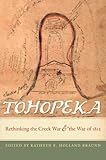Tohopeka : rethinking the Creek war and the war of 1812 / edited by Kathryn E. Holland Braund.
Material type: TextPublisher: Tuscalosa, AL : University of Alabama Press, [2012]Copyright date: ©2012Description: 1 online resourceContent type:
TextPublisher: Tuscalosa, AL : University of Alabama Press, [2012]Copyright date: ©2012Description: 1 online resourceContent type: - text
- computer
- online resource
- 0817386157
- 9780817386153
- Creek War, 1813-1814
- Horseshoe Bend, Battle of, Ala., 1814
- Indians of North America -- Wars -- 1812-1815
- United States -- History -- War of 1812
- Guerre creek, 1813-1814
- Bataille de Horse Shoe, Alab., 1814
- Indiens d'Amérique -- Guerres -- États-Unis -- 1812-1815
- États-Unis -- Histoire -- 1812, Guerre de
- HISTORY -- United States -- 19th Century
- Indians of North America -- Wars
- Alabama
- United States
- Battle of Horseshoe Bend (Alabama : 1814)
- Creek War (1813-1814)
- War of 1812 (United States : 1812-1815)
- 1812-1815
- 973.5 23
- E83.813
| Item type | Home library | Collection | Call number | Materials specified | Status | Date due | Barcode | |
|---|---|---|---|---|---|---|---|---|
 Electronic-Books
Electronic-Books
|
OPJGU Sonepat- Campus | E-Books EBSCO | Available |
"A Pebble Hill Book."
Includes bibliographical references (pages 273-299) and index.
"Tohopeka contains a variety of perspectives and uses a wide arrayof evidence and approaches, from scrutiny of cultural and religious practices to literary and linguistic analysis, to illuminate this troubled period. Almost two hundred years ago, the territory that would become Alabama was both ancient homeland and new frontier where a complex network of allegiances and agendas was playing out. The fabric of that network stretched and frayed as the Creek Civil War of 1813-14 pitted a faction of the Creek nation known as Red Sticks against those Creeks who supported the Creek National Council. The war began in July 1813, when Red Stick rebels were attacked near Burnt Corn Creek by Mississippi militia and settlers from the Tensaw area in a vain attempt to keep the Red Sticks' ammunition from reaching the main body of disaffected warriors. A retaliatory strike against a fortified settlement owned by Samuel Mims, now called Fort Mims, was a Red Stick victory. The brutality of the assault, in which 250 people were killed, outraged the American public and "Remember Fort Mims" became a national rallying cry. During the American-British War of 1812, Americans quickly joined the war against the Red Sticks, turning the civil war into a military campaign designed to destroy Creek power. The battles of the Red Sticks have become part of Alabama and American legend and include the famous Canoe Fight, the Battle of Holy Ground, and most significantly, the Battle of Tohopeka (also known as Horseshoe Bend) - the final great battle of the war. There, an American army crushed Creek resistance and made a national hero of Andrew Jackson. New attention to material culture and documentary and archaeological records fills in details, adds new information, and helps disabuse the reader of outdated interpretations."--Project Muse.
List of Illustrations; Foreword: A Deliberate Passion -- Marianne Mills; Preface -- Jay Lamar; Acknowledgments; Introduction -- Kathryn E. Holland Braund; 1. Causalities and Consequences of the Creek War: A Modern Creek Perspective -- Robert G. Thrower; 2. Thinking outside the Circle: Tecumseh's 1811 Mission -- Gregory Evans Dowd; 3. "A Packet from Canada": Telling Conspiracy Stories on the 1813 Creek Frontier -- Robert P. Collins; 4. Red Sticks -- Kathryn E. Holland Braund; 5. Before Horseshoe: Andrew Jackson's Campaigns in the Creek War Prior to Horseshoe Bend -- Tom Kanon
6. Cherokees in the Creek War: A Band of Brothers -- Susan M. Abram7. Horseshoe Bend: A Living Memorial -- Ove Jensen; 8. Fort Jackson and the Aftermath -- Gregory A. Waselkov; 9. "We Bleed Our Enemies in Such Cases to Give Them Their Senses": Americans' Unrelenting Wars on the Indians of the Trans-Appalachian West, 1810-1814 -- John E. Grenier; 10. "Where All Behave Well": Fort Bowyer and the War on the Gulf,1814-1815 -- David S. Heidler and Jeanne T. Heidler; 11. Archaeology, Geography, and the Creek War in Alabama -- Craig T. Sheldon Jr.
12. Digging Twice: Camps and Historical Sites Associated with the Warof 1812 and the Creek War of 1813-1814 -- James W. ParkerAfterword: The Western Muscogee (Creek) Perspective -- Ted Isham; Appendix I: Current Preservation Status of Major Creek War / War of 1812 Sites in Alabama; Appendix 2: Known and Potential Archaeological Sites in Alabama; Bibliography; Contributors; Index
eBooks on EBSCOhost EBSCO eBook Subscription Academic Collection - Worldwide
There are no comments on this title.

